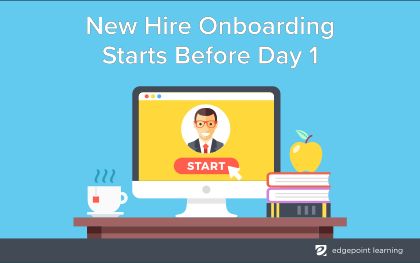Your Step-By-Step Guide To Better New Hire Onboarding
Michael Hansen
🍿 5 min. read
Your step-by-step checklist for better new hire onboarding.
These days, effective new hire onboarding is more than just showing rookie employees where they can hang their coat and get free coffee. With fierce competition for qualified people, your employee onboarding process can be the difference between happy employees that stay and employees who leave before their probationary period is up. Here’s your step-by-step checklist for better new hire onboarding.
What is new hire onboarding?
New hire onboarding is the training process you use to transmit your company’s culture, values, and processes to every person who joins your team.
Traditionally, there are five stages to new hire onboarding. Understanding the flow of these can help you better structure your processes.
Stage 1: Offer, acceptance, and lead-up
New hire onboarding starts with an offer that is courteous, respectful, and enthusiastic. This makes employees feel wanted and valued.
Once the offer is accepted, in the weeks leading up to the employees first day, send employee forms and paperwork to be completed before they come in. This saves time and helps them hit the ground running. It also offers them an opportunity to ask questions.
Stage 2: Day before the first day
The day before the first day is a great time to prep a welcome packet in the office. Talk to the employee's manager to make sure they have everything sorted.
Make sure the new employee's technology and equipment is all set and ready to go for their first day.
Stage 3: Day one
Day one for any new employee is packed with meet-and-greets, welcomes from different departments, confidential paperwork review with HR, and, of course, a welcome lunch.
For many people, having a structured agenda and point-person can calm some of the chaos of this day.
Stage 4: Week 1 follow-up
Although you will check in during the week, it’s good to build in a formal one-on-one meeting at the end of an employee's first week to answer any questions and make sure the new hire feels prepared for their work.
This is not an evaluation of the new hire’s work – just a check in to see how things are going.
Stage 5: Ongoing evaluation
The final stage of new hire onboarding is ongoing evaluations. These can be set at intervals that meet the needs of your company, like one after a month, one after six months, and one after a year.
Think of them as opportunities to make sure your new hire has all the tools they need to do their job rather than performance evaluations. Those can be scheduled at regular intervals, too, but the onboarding process is really about supporting your new hire as they transition fully into their new role.
Where to start with new hire onboarding?
There are many points to cover within each stage of new hire onboarding. It can be overwhelming to keep track of who’s done what and when.
Here are eight actionable steps to simplify your employee onboarding process flow. Make sure you share this information with any HR personnel or managers who are managing this process.
1. Decide what information they need
If you have never taken the time to figure out what information all employees need to know, step one is to sit down with various department heads (and the C-suite) to figure out what they want new hire onboarding to consist of.
Consider including information about:
- Your organization's mission and vision
- Company culture
- Expectations in terms of work ethic
- Required trainings (in the beginning and ongoing)
- Basic information, like your leave and benefits policies
Each company has a unique opportunity to mold new hires into the shape they would like them—but only at the very beginning. Make it crystal clear what you’d like to transmit ahead of time so you know you're doing it for every employee.
2. Implement new hire onboarding at least a week ahead of their start date
The companies with the biggest returns start employee onboarding well before their first day of work.
Be like those companies and clarify crucial information ahead of time. A week is good. For higher-level employees, more time may be necessary.

3. Break down each block of information and assign it
New hire onboarding is a big job, so break down the tasks and assign them to different people in your organization.
HR can handle taxes and medical enrollments, but do they really need to train employees on your specific technology? Hand that over to your IT department. Managers or team leads can take on the bulk of training about new processes.
4. Use new hire onboarding checklists
Checklists standardize procedures to make sure that everyone is getting what they need when they start. The very best checklists not only lay out what is information needs to be delivered but also set deadlines and assign tasks.
Some of our favorites include:
- Trello: This includes avatars and the ability to develop department-specific tasks
- Smartsheet: Smartsheet coordinates checklists across HR and other departments
- Process Street: Process Street is an easy-to-use checklist that outlines what needs to happen before day one (and beyond)
5. Design appropriate new hire training
You've outlined what topics employees should know in their first month and first year at your company. Now it's time to get that information to them.
The delivery method will depend on the information itself. Microlearning training takes 300% less time and costs 50% less for you to put together. New hires can learn on their own time (and take learning with them wherever they go). This may be appropriate for more general information, or information they'll access regularly (like leave policies).
Maybe some information is best delivered in small groups so the employee can meet their team. Or maybe you create a role-playing simulation for customer service training that uses gamification. Match the training style to the information for best results.

6. Set up a delivery schedule – and stick to it
Trainings can fall by the wayside when business gets going. Set up a training schedule and make sure all players stick to it.
Building it into a daily routine (instead of an add-on) is respectful of your new hire’s time, too.
7. Allocate appropriate resources
Time is just one of the resources you need to dedicate to your new hire onboarding process.
If your new employees need equipment or software for training, make sure they have it. Do they need access to upper management or HR to ask questions? Include that in your training resources.
8. Track results
Many of the checklists we mentioned above have space built-in to track not only completion of training but also the outcomes. Tracking employee training is crucial, especially when it comes to certifications and licensing.
Build this into your new employee onboarding flow from the start.
See new hire onboarding in action
There are plenty of employee onboarding examples that have structured processes to make new hire onboarding smooth and successful.
EdgePoint Learning was lucky to work with the talented team of scientists, planners, and technical specialists of SWCA Environmental Consultants to streamline and standardize their onboarding procedures. We designed a self-paced employee onboarding process that clearly articulated not only the philosophy of the company but also delivered practical information such as employee benefits, basic policies and procedures, and OSHA and safety requirements.
After the training, employees felt confident in their roles, and retention rates increased.
If you need help developing a new hire onboarding process, get in touch with EdgePoint to get started today. We're happy to set up demos of our new hire onboarding activities and options.
